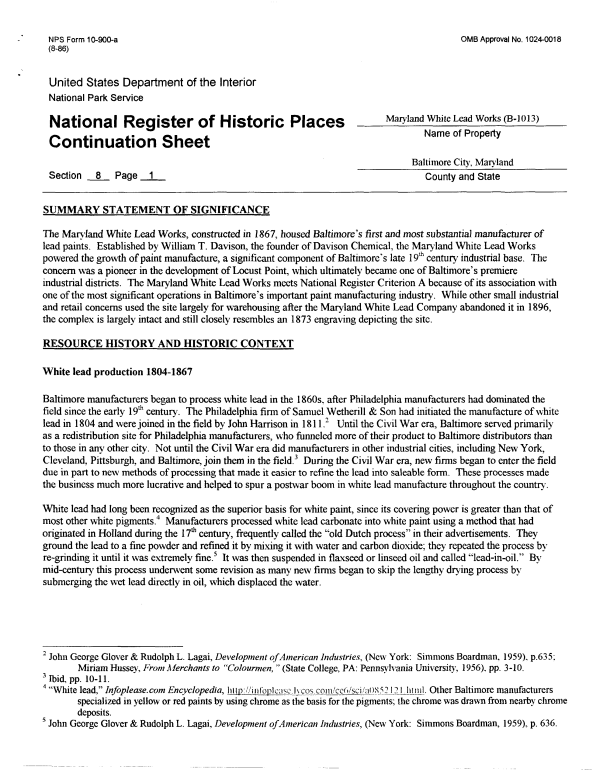 |
||||
|
DEPARTMENT OF HOUSING AND COMMUNITY DEVELOPMENT, MARYLAND HISTORICAL TRUST (Historic Sites Survey) var.d. MSA SE16-2 Image No: se16-2-0009 Enlarge and print image (81K) |
 |
||||
|
DEPARTMENT OF HOUSING AND COMMUNITY DEVELOPMENT, MARYLAND HISTORICAL TRUST (Historic Sites Survey) var.d. MSA SE16-2 Image No: se16-2-0009 Enlarge and print image (81K) |
| NPS Form 10-900-a OMB Approval No. 1024-0018 (8-86) United States Department of the Interior National Park Service National Register of Historic Places M^land WhiteLeadWorks(B-1013) -, .. .. —. x Name of Property Continuation Sheet Baltimore City, Maryland Section 8 Page _1_ County and State SUMMARY STATEMENT OF SIGNIFICANCE The Maryland White Lead Works, constructed in 1867, housed Baltimore's first and most substantial manufacturer of lead paints. Established by William T. Davison, the founder of Davison Chemical, the Maryland White Lead Works powered the growth of paint manufacture, a significant component of Baltimore's late 19th century industrial base. The concern was a pioneer in the development of Locust Point, which ultimately became one of Baltimore's premiere industrial districts. The Maryland White Lead Works meets National Register Criterion A because of its association with one of the most significant operations in Baltimore's important paint manufacturing industry. While other small industrial and retail concerns used the site largely for warehousing after the Maryland White Lead Company abandoned it in 1896, the complex is largely intact and still closely resembles an 1873 engraving depicting the site. RESOURCE HISTORY AND HISTORIC CONTEXT White lead production 1804-1867 Baltimore manufacturers began to process white lead in the 1860s, after Philadelphia manufacturers had dominated the field since the early 19th century. The Philadelphia firm of Samuel Wetherill & Son had initiated the manufacture of white lead in 1804 and were joined in the field by John Harrison in 1811,2 Until the Civil War era, Baltimore served primarily as a redistribution site for Philadelphia manufacturers, who tunneled more of their product to Baltimore distributors than to those in any other city. Not until the Civil War era did manufacturers in other industrial cities, including New York, Cleveland, Pittsburgh, and Baltimore, join them in the field.3 During the Civil War era, new firms began to enter the field due in part to new methods of processing that made it easier to refine the lead into saleable form. These processes made the business much more lucrative and helped to spur a postwar boom in white lead manufacture throughout the country. White lead had long been recognized as the superior basis for white paint, since its covering power is greater than that of most other white pigments.4 Manufacturers processed white lead carbonate into white paint using a method that had originated in Holland during the 17th century, frequently called the "old Dutch process" in their advertisements. They ground the lead to a fine powder and refined it by mixing it with water and carbon dioxide; they repeated the process by re-grinding it until it was extremely fine.5 It was then suspended in flaxseed or linseed oil and called "lead-in-oil." By mid-century this process underwent some revision as many new firms began to skip the lengthy drying process by submerging the wet lead directly in oil, which displaced the water. 2 John George Glover & Rudolph L. Lagai, Development of American Industries, (New York: Simmons Boardman, 1959), p.635; Miriam Hussey, From Merchants to "Colourmen, " (State College. PA: Pennsylvania University, 1956), pp. 3-10. 3 Ibid, pp. 10-11. 4 "White lead," lnfoplease.com Encyclopedia, liiip://injorj|c;isc.lycos.coni/ccC>/sci/nOS52121 hlnil. Other Baltimore manufacturers specialized in yellow or red paints by using chrome as the basis for the pigments; the chrome was drawn from nearby chrome deposits. 5 John George Glover & Rudolph L. Lagai, Development of American Industries, (New York: Simmons Boardman, 1959), p. 636. |